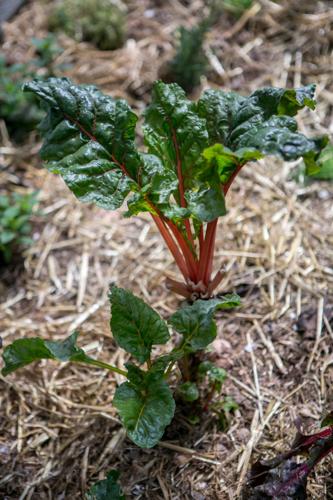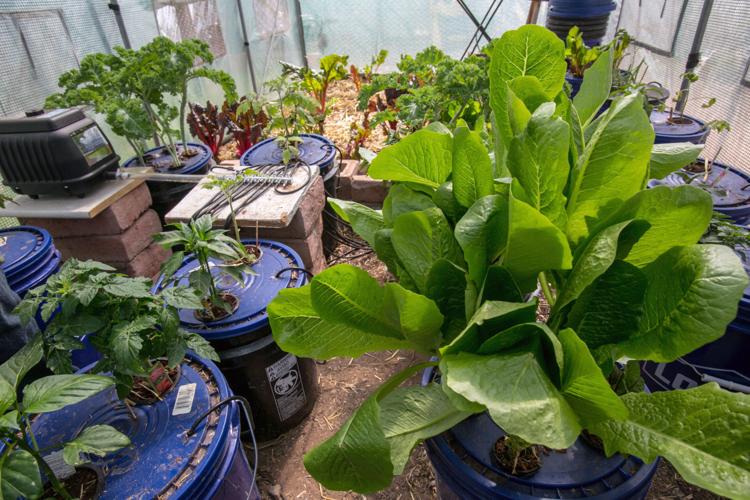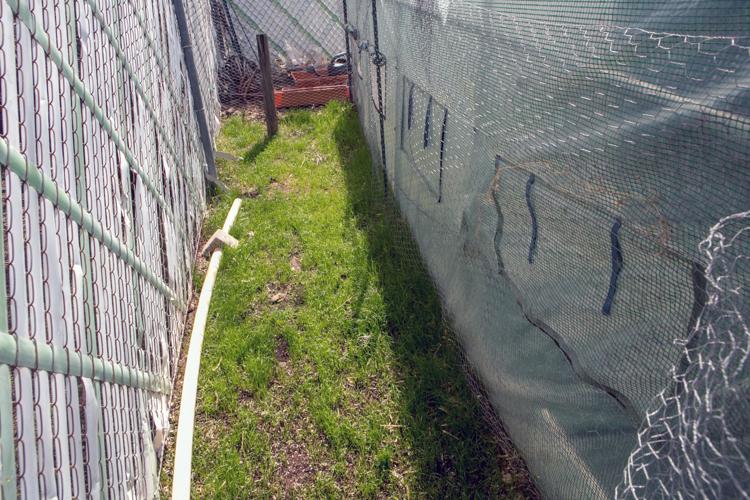Don’t tell Charles Collins that he can’t grow leafy greens in the Tucson summer.
He will prove you wrong.
Exhibit A: his “chard yard,” a plot of land inside an 8-by-15-foot, Quonset hut-style greenhouse in the backyard of his northside home.
His two-year-old plants have stalks as thick as those found on broccoli. Leaves continue to issue from the top half of the stalk. Baby plants have grown out of the ground from the roots of those mature plants. Collins also adds new starts every year.
Exhibit B: Leafy curly kale, Bibb lettuce and broccoli greens with thumb-sized crowns grow in 5-gallon buckets as a hydroponic garden in about half of the green-netted greenhouse.

Lettuce is plentiful in Charles Collins’ greens garden in the backyard of his home near Stone Ave. & Pastime Rd. in Tucson, AZ. on March 6, 2018.
These are all traditionally grown in the winter in Tucson, but Collins, who works at Kitt Peak National Observatory, wasn’t about to let seasons get in the way of his gardening.
“I took it as a challenge,” Collins replies when asked why he works hard to keep his greens growing all year. “I don’t quit.”
Collins, a Navy veteran of Desert Storm, says he got into gardening because he and his wife like to try things that are hard.
“We looked at growing in the desert as a challenge,” the upstate New York native says.
Indeed, he wasn’t much of a gardener until he moved to Tucson about four years ago for his health. “I was the worst gardener,” he says. “I had to go to the desert to grow something.”
Collins focused his efforts on adapting to the needs of desert growing, including saving water and amending soil.
His garden is a study on recycling resources. The soil in the chard yard is regularly fed by homemade compost that includes poop from his 11 chickens.
It’s irrigated from laundry gray water and the hydroponics system, which needs its water replaced every 15 to 20 days.
A small electric pump circulates some 2,500 gallons of fertilized, pH-balanced city water through 17 hardware store buckets. Plants grow through holes in the bucket lids.

Charles Collins in his greens garden in the backyard of his home near Stone Ave. & Pastime Rd. in Tucson, AZ. on March 6, 2018.
The greenhouse and additional shade cover provide some humidity for the plants while blocking out about 50 percent of the sunlight. The sun block and uncovered screens on the sides of the greenhouse help maintain enough cool air to keep the greens from bolting.
The shade cover can be removed or adjusted to allow more sunlight when the plants need it, particularly the summer crop of tomatoes, peppers, onion and garlic chives, tarragon, thyme, sage and oregano that also grow on the hydroponics system.
Aphids and other pests tend to attack winter leafy greens that continue to grow in the summer. Collins is vigilant about taking the bugs off with adhesive tape.
“The biggest problem I encounter are the caterpillars during monsoon season,” he says, “but a quick spray of thuricide fixes the problem.”
The greenhouse also is a get-away for Collins, who does computer systems database design. He sits on his lawn chair, listens to the water gurgling and snaps off leaves to munch on. “I’ll come out here and just pig out,” he says.
In the future he wants to install a solar panel that will run the electric pump.
Collins’ garden keeps his household of four—another child lives away from home—well-stocked with greens all year. He wants to teach others how to set up a modest hydroponics system for as low as $12.
Says Collins: “We really want to feed the hungry, one bucket at a time.”

Charles Collins grows onions and spices alongside his home greenhouse near Stone Ave. & Pastime Rd. in Tucson, AZ. on March 6, 2018.
Keeping chard and kale growing through the summer isn’t impossible, but it is hard.
“We kept some chard going last summer,” says Lisa Carter, a grower at the Tucson Village Farm. They tasted bitter as the temperature rose, she reports.
Carter and Jessica Paul, the gardens manager for Community Gardens of Tucson, suggest a few other greens that can take Tucson’s summer conditions.
Malabar spinach. The leafy vine “tastes like slimy spinach” when eaten raw, Paul says, but it cooks up well.
Carter suggests planting seeds now in partial shade for harvesting in June or July.
Purslane. Like Malabar spinach, this succulent has a sticky texture when eaten raw. Paul says it’s a popular addition to scrambled eggs.
Also known as verdolagas, the green is a “super food,” says Carter.
Plant seed in partial shade now for a harvest as early as May. “The purslane’s going to grow really fast,” she says.
Amaranth. While amaranth is cultivated for its grain, the leaves are edible.
“We eat the leaves when they’re small,” says Carter. “They are tough once they grow.”
Sweet potato. While prized for its tubers, the plant’s leaves also are edible when cooked.
To grow sweet potato, Carter says, put a tuber slip in water so that it sprouts. In late April, plant the shoots upright in soil and full sun. Leaves should be ready to harvest starting in June.
Herbs. In keeping with the idea of greens versus fruit, Paul says plants used for seasoning thrive in the Tucson heat. Basil in particular is “really easy” to grow in the summer, she says. She also suggests marjoram and dill.
Flowers. OK, not even green, but marigold and nasturtium are two popular edible blossoms that grow well in the summer, Paul says.









